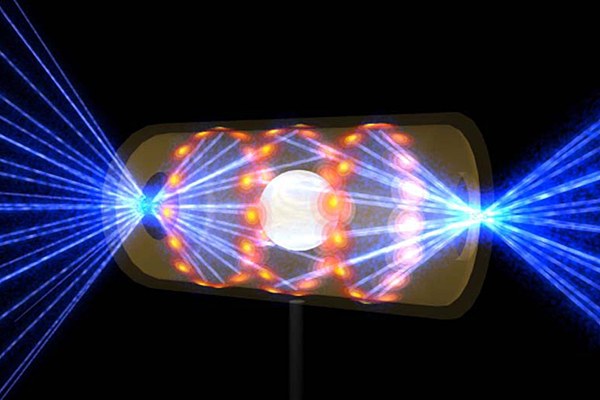Energy question of the week: Can lasers unleash the Sun's power to create a fusion reactor?
Using the power of 192 laser beams focused on a single point, scientists working on a 3.5-billion-dollar fusion experiment at the Lawrence Livermore National Laboratory (LLNL) in California hope to pave the way for nuclear fusion. At temperatures in excess of 3 billion degrees Celsius, hydrogen nuclei fuse to form heavier helium nuclei, releasing vast amounts of energy in the process – significantly more than is required to trigger the nuclear fusion. Just a few weeks ago, the researchers reported in Science that test runs had been successful and that it would be possible to attempt the first fusion reaction later this year.
Nuclear fusion at 3.3 million degrees Celsius
"So far, it has been working better than anyone could have expected," said Siegfried Glenzer from the National Ignition Facility (NIF) at LLNL. For the last several years, his team has been preparing this gargantuan fusion experiment in collaboration with many colleagues from affiliated institutions. Housed in a building ten storeys high, covering an area equivalent to three football fields, the 192 laser beams are directed through elaborate optical equipment at a hollow cylinder made of gold and measuring just a few millimetres across. The energy concentrated on this point can measure up to 1.8 Megajoules. At a temperature of 3.3 million degrees Celsius, the gold evaporates and an implosion of charged particles and X-rays creates plasma. These conditions should be sufficient to cause hydrogen nuclei to fuse and form heavier helium nuclei.

Artist's impression: at temperatures in excess of 3 million degrees Celsius, hydrogen nuclei fuse to form heavier nuclei of helium. Credit (both images): NIF.
To date, these preliminary trials have been carried out in the absence of the fuel required for nuclear fusion – the heavy hydrogen isotopes deuterium and tritium. In the course of this year, Dr Glenzer and colleagues are hoping to take the next step, which involves placing fusion fuel inside a beryllium capsule the size of a peppercorn at the centre of the hollow gold cylinder. It may then prove possible to ignite a fusion reaction that can be sustained without continued heating from the laser beams.
Race between laser fusion and the European ITER fusion reactor
When the laser fusion experiment enters this next crucial phase will be decided in June. Scientists are not yet able to tell whether it will in fact be possible to ignite a nuclear fusion reaction. Should they succeed, the American fusion experiment will be competing with the European ITER fusion reactor, which is under construction at Cadarache, southern France at present. In contrast to their American colleagues, the researchers at ITER are not using laser ignition. Instead, they are striving to create a million-degree plasma and to contain it within an extremely powerful magnetic field. In the predecessor to ITER, the JET test reactor in the UK, it proved possible to sustain a fusion reaction for a few seconds. Progress came in small steps, most of which were taken at German institutions in Karlsruhe, Garching and Greifswald, making ITER the current favourite in the race.
No one knows yet which concept will turn into the first viable fusion reactor. The only certainty is the researchers' forecast that it will be a few more decades before electrical power can be generated cost-effectively using nuclear fusion. If and when they are successful, be it with lasers or with magnetic fields, the future energy needs of mankind will be assured.
Further information on nuclear fusion:
ITER experimental fusion reactor
National Ignition Facility (NIF)
The DLR Energy question of the week in 'The future of energy' Year of Science
The Federal Ministry of Education and Research (BMBF) has given the Year of Science 2010 the motto 'The future of energy'. For this reason the science journalist Jan Oliver Löfken will this year answer a question on the subject of energy in his blog each week. Do you have a question about how our energy supply might look in the future? Or do you want to know, for example, how a wave power plant works and how it can efficiently generate electricity? Then send us your question by email. Science journalist Jan Oliver Löfken will investigate the answers and publish them each week in this blog.
Tags:
